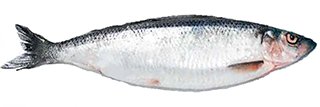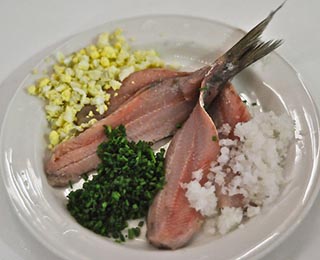Herring fish Nutrition facts
Herring fish are round, oily, pelagic seafood found abundantly in almost all the major oceans of the world, especially in the Atlantic and Pacific oceans.
Scientific name: Atlantic herring species- Clupea harengus. Pacific herring -Clupea pallasii.
Herring is also known by regional names as hareng in French, hering in German, arenque in Spanish, and aringa in Italian.
 |
| Herring fish. |
Description
Herring features a smooth, slender body, with silvery skin with hints of green and blue. The body is covered with large, thin, loosely attached scales. The mouth is large with a blackish-blue snout. The lower jaw protrudes slightly beyond the upper. The tail fin is deeply forked.
They range in size from 100-350g. Herring measures 6 to 12 inches 15 to 30 cm in length but can achieve a maximum length of 17 inches. It weighs 0.5 to 1.5 pounds. The shape of the earring varies slightly depending on species and habitat. White oily and tasty flesh contains many bones that are easily removed.
Habitat
Herring is temperate water coastal pelagic fish. It is found at depths of 10 and 400 m below the surface of the sea. The adult herring feeds mainly on tiny copepods (crustaceans), mysid shrimps, and small fishes near the surface of the sea.
Health Benefits of Herring fish
Herring fish holds 158 calories per 100 g. Herring and its processed products contain numerous health-benefiting essential fatty acids, protein, minerals, and vitamins that improve overall health and well-being .
Herrings, just like sardines, are an oily-fish. Hence, they are an ideal source of fat-soluble vitamins like vitamin A, vitamin D, and more importantly, long-chain Omega-3 fatty acids (PUFA).
Protein in herring fish is easily digestible and composes all the essential amino acids in the right proportions for optimum growth and development.
Herring fish muscles composes excellent amounts of omega-3s fatty acids such as eicosapentaenoicacid (EPA) and docosahexaenoic acid (DHA) . 2.0 oz serving contains 1,200 mg of omega-3s. Research studies suggest that these fatty acids, particularly DHA, play an important role in the development of neural systems, especially in infants and children.
Seafood consumption is also known to have health benefits among the adult population. Several large trials have evaluated the effect of fish or fish oils on heart disease. In the "GISSI Prevention Trial, heart attack survivors who took a 1-gram capsule of omega-3 fats every day for three years were less likely to have a repeat heart attack, stroke, or die of sudden death than those who took a placebo".
Herring are a modest source of vitamin A (84 IU/100 g). vitamin-A and omega-3's are essential for healthy mucosa and skin, and acuity of vision .
100 g herring holds 168 IU of vitamin D; about 42% of daily recommended intake. Vitamin D plays an important role in calcium metabolism and offers protection from cancers.
Herring is "best-choice"-low mercury seafood. The Food and Drug Administration (FDA) recommends that pregnant women eat at least 8 ounces and up to 12 ounces (340 grams) of a variety of seafood lower in mercury a week.
Further, herrings are a quintessential source of bone minerals including calcium, phosphorus, and magnesium. This marine fish also contains very good amounts of trace elements like selenium and iodine.
| Principle | Nutrient Value | Percent of RDA |
|---|---|---|
| Energy | 158 Kcal | 6% |
| Carbohydrates | 0 g | 0% |
| Protein | 17.96 g | 32% |
| Total Fat | 9.04 g | 45% |
| Cholesterol | 60 mg | 30% |
| Dietary Fiber | 0.5 g | 1% |
| Vitamins | ||
| Folates | 10 μg | 2.5% |
| Niacin | 3.217 mg | 20% |
| Pyridoxine | 0.302 mg | 23% |
| Riboflavin | 0.233 mg | 18% |
| Thiamin | 0.092 mg | 7.6% |
| Vitamin-A | 84 IU | 2.8% |
| Vitamin-C | 0.7 mg | 1% |
| Vitamin-D | 168 IU | 42% |
| Vitamin-E | 1.07 mg | 7% |
| Vitamin-K | 0.1 μg | <1% | Electrolytes |
| Sodium | 90 mg | 6% |
| Potassium | 327 mg | 7% |
| Minerals | ||
| Calcium | 57 mg | 6% |
| Iron | 1.1 mg | 13.75% |
| Magnesium | 32 mg | 8% |
| Phosphorus | 236 mg | 33% |
| Selenium | 36.5 mg | 66% |
| Zinc | 0.99 mg | 9% |
| Omega-3's (PUFA) | ||
| EPA (20:5 n-3) | 0.709 g | -- |
| DPA (22:5 n-3) | 0.055 g | -- |
| DHA (22:6 n-3) | 0.862 g | -- |
Buying
Herring fish is highly perishable if not processed early and stored adequately. Just like other pelagic fish, fresh herrings are often sold by coastal fishermen who sell them soon after catching them from the ocean.
At home, store them in the freezer section for extended use.
Herring is one of the most plentiful and harvested saltwater fish in the world. It sold fresh and frozen, whole or fillets but also canned, marinated, salt-cured, and smoked.
Cured herring is sold in cans. Bloater is usually a whole herring, un-gutted, barely salted, semi-smoked. It keeps for 5 days. Buckling is lightly brined, hot-smoked, and thus partly cooked, which can be eaten without further cooking. It is especially popular in Germany and Holland. Buckling keeps for 4 days.Kipper is a large herring with its head removed, split into along the back, boned, flattened, and barely smoked (cold). Kippers can be eaten as is or they can be cooked for a few minutes. They sold fresh in cans, frozen, or in ready-to-cook sachets. They keep for 5 days.
Pickled herring fish
Pickled herrings are a popular, traditional accompaniment in German, Dutch, and other Scandinavian cuisines. Salt-cured herrings are typically preserved in vinegar and spices like peppercorn, bay leaves, mustard, etc.
Preparation
Herring fish contains small bones, which are best removed before cooking. Prepare them just like other small, round fish. Remove the fins and trim the tail. To scale the herring, simply wipe it.
To gut the fish, lay it on a board with the skin side up. Turn the fish over. Cut off the head, almost through the spine, and twist, gently pull the innards away from the head. Press down along the backbone and gently pull the backbone away from the flesh. Pick out any left-over small bones.
Wash in cold water and pat dry with kitchen paper.
Here are some serving ideas:
 |
| Dutch herring recipe. Photo credit: Jeffrey Bary |
Herring can replace mackerel in many recipes. It is very often marinated, smoked, and canned.
Herrings are best grilled or baked or pan-fried whole. They are not suited for poaching. Avoid overcooking.
In traditional Scottish recipe, herring fish are rolled in coarse oatmeal and fried in bacon fat.
Herrings are most popular in their various smoked and cured forms.
Safety profile
Being a small, coastal pelagic oily fish, herrings contain traces of heavy metals and dioxins (Polychlorinated dibenzodioxins (PCDDs)). However, this toxin is too small unlike other large fish like tuna, and therefore considered safe to eat up to 12 ounces (2 average meals) a week.
Avoid if your herrings are from known polluted pelagic waters where the risks of exposure to these compounds are high due to environmental pollution. Pay attention to local advisories. If advice isn't available, limit its consumption to 6 ounces (170 grams) a week.
The mean mercury concentration in herring fish is 0.078 ppm. Accordingly, the U.S. FDA final guidelines on how much fish expectant as well as breastfeeding mothers can eat, along with lists of specific options that are safe or should be avoided, place Hake in the "best choice" category. By this yardstick, they can consume 2-3 servings (8-1 ounces) of herrings per week.
Pickled herring is rich in tyramine and thus, should be avoided in the diet of people on antidepressant medication with monoamine oxidase (MAO) inhibitors.
(Medical disclaimer).Also read ≻≻-
≻≻-Sardines nutrition facts and health benefits.
≻≻-Salmon nutrition facts and health benefits.
≻≻-Anchovies nutrition facts and health benefits.
≻≻-Back to Seafood from Herring fish nutrition facts and health benefits.
Further reading (Links opens in new window):
Omega-3 Fatty Acids: An Essential Contribution.